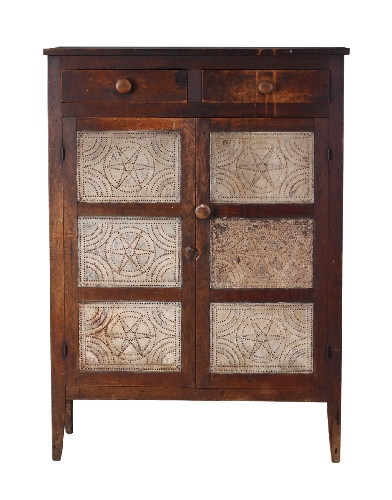Antique furniture often had specific purpose

Go to an antique show and you might see a pie safe, jelly cupboard or sugar chest. But most beginning collectors would call each a “cupboard” or “chest” with no idea how the furniture was originally used.
A pie safe, also called a kitchen safe, is easy to identify. It is a rectangular cupboard, usually with two doors that have pierced tin panels. Pies and other food items were safe behind the metal doors and kept fresh because air could circulate through the pierced holes. Popular from the mid-18th century to the early 20th, it went out of use when refrigeration arrived.
A jelly cupboard is a Midwestern term for a two-drawer, two-door kitchen cupboard used for storage. In all other parts of the country, it is known as a cupboard.
A sugar chest looks like a large storage chest on feet. It has a lift lid and a lock. It is a Southern piece of furniture used to store sugar and was not used in other parts of the country. The inside was divided into sections, one for brown sugar, the other for more expensive white sugar. It was locked because sugar was expensive.
See if you can identify some of these outdated pieces of furniture on your next visit to a show or flea market. They still are popular with collectors, who often use them to store clothes.
Q: My mother left me an 8-inch-high jardiniere she told me was in Roseville’s Cherry Blossom pattern. It’s brown with a tan trellis around the bottom and white floral vines around the top. The trouble is that it’s not marked except with a crayoned number. Could it really have been made by Roseville? I know it’s at least 60 years old.
A: You can believe your mother. Roseville Pottery introduced its Cherry Blossom pattern in 1933. Pieces were brown and tan, like yours, or green and pink. Cherry Blossom pieces were marked with only a foil label — and by now most of those labels have been lost. Some pieces, like yours, had hand-crayoned shape numbers on the bottom.
An 8-inch Cherry Blossom jardiniere in excellent condition can sell for more than $500.
Q: I have a child’s Mickey Mouse ring. I think it’s sterling silver and from the 1930s. Could you tell me what it’s worth?
A: The only sterling silver Mickey Mouse rings on the market before the 1980s were made from 1947 to 1949 by Ostby & Barton of Providence, R.I. One of those rings sells for about $50 today. But many other silver Mickey rings have been made in recent years. You have to do some research to be sure you have an old ring.
Terry Kovel’s column is syndicated by King Features. Write to: Kovels, (Las Vegas Review-Journal), King Features Syndicate, 300 W. 57th St., New York, NY 10019.